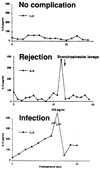Daily serum interleukin-6 monitoring in multiple organ transplantation with or without liver allografts
- PMID: 8658638
- PMCID: PMC2955296
Daily serum interleukin-6 monitoring in multiple organ transplantation with or without liver allografts
Figures








Similar articles
-
Daily serum inflammatory cytokine (tumor necrosis factor-alpha, interleukin-6) monitoring in liver transplantation focusing on allograft rejection: a five-case report.Transplant Proc. 1996 Jun;28(3):1237-40. Transplant Proc. 1996. PMID: 8658640 Free PMC article. No abstract available.
-
Serum levels of interleukin-6, tumor necrosis factor-alpha, and interleukin-2 in rejecting human small bowel allografts.Transplant Proc. 1992 Jun;24(3):1152. Transplant Proc. 1992. PMID: 1604565 Free PMC article. No abstract available.
-
Annual review of transplantation.Clin Transpl. 1990:357-73. Clin Transpl. 1990. PMID: 2129410 Review. No abstract available.
-
Three years of follow-up of bone marrow-augmented organ transplant recipients: the impact on donor-specific immune modulation.Transplant Proc. 1997 Feb-Mar;29(1-2):1205-6. doi: 10.1016/s0041-1345(96)00552-0. Transplant Proc. 1997. PMID: 9123274 Free PMC article. No abstract available.
-
A brief focus on memory cells in transplantation.Transplant Proc. 2009 Oct;41(8):3361-2. doi: 10.1016/j.transproceed.2009.08.044. Transplant Proc. 2009. PMID: 19857749 Review.
Cited by
-
Pediatric patients receiving ABO-incompatible living related liver transplantation exhibit higher serum transforming growth factor-β1, interferon-γ and interleukin-2 levels.Pediatr Surg Int. 2011 Mar;27(3):263-8. doi: 10.1007/s00383-010-2784-1. Pediatr Surg Int. 2011. PMID: 21046118
References
Publication types
MeSH terms
Substances
Grants and funding
LinkOut - more resources
Full Text Sources
Other Literature Sources
Medical
